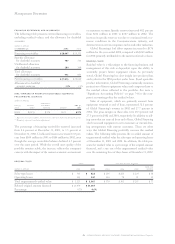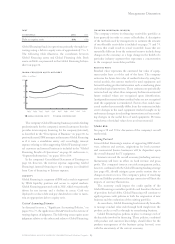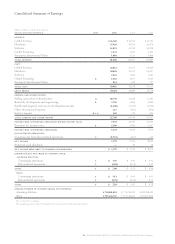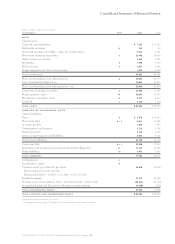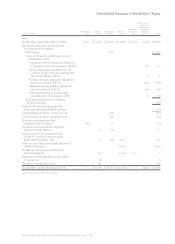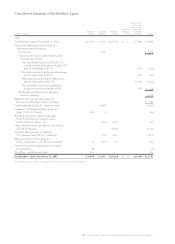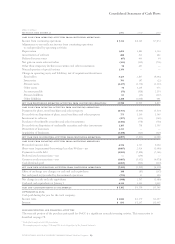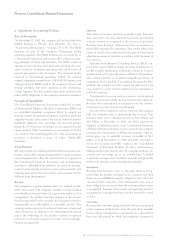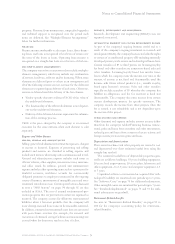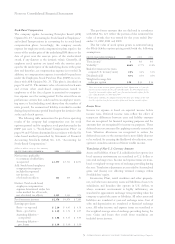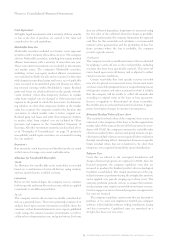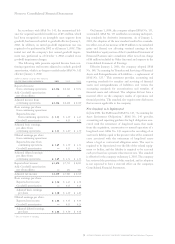IBM 2002 Annual Report Download - page 73
Download and view the complete annual report
Please find page 73 of the 2002 IBM annual report below. You can navigate through the pages in the report by either clicking on the pages listed below, or by using the keyword search tool below to find specific information within the annual report.Notes to Consolidated Financial Statements
71international business machines corporation and Subsidiary Companies
program. Revenue from maintenance, unspecified upgrades
and technical support is recognized over the period such
items are delivered. See “Multiple-Element Arrangements”
below for further information.
financing
Finance income attributable to sales-type leases, direct financ-
ing leases and loans is recognized at level rates of return over
the term of the leases or loans. Operating lease income is
recognized on a straight-line basis over the term of the lease.
multiple-element arrangements
The company enters into transactions that include multiple-
element arrangements, which may include any combination
of services, hardware, software and/or financing. When some
elements are delivered prior to others in an arrangement and
all of the following criteria are met, revenue for the delivered
element is recognized upon delivery of such item. Otherwise,
revenue is deferred until the delivery of the last element.
■
Vendor-specific objective evidence (VSOE) of fair value of
the undelivered elements.
■
The functionality of the delivered elements is not depend-
ent on the undelivered elements.
■
Delivery of the delivered element represents the culmina-
tion of the earnings process.
VSOE is the price charged by the company to an external
customer for the same element when such element is sold
separately.
Expense and Other Income
selling, general and administrative
Selling, general and administrative (SG&A) expense is charged
to income as incurred. Expenses of promoting and selling
products and services are classified as selling expense and
include such items as advertising, sales commissions and travel.
General and administrative expense includes such items as
officers’ salaries, office supplies, non-income taxes, insurance
and office rental. In addition, general and administrative
expense includes other operating items such as a provision for
doubtful accounts, workforce accruals for contractually
obligated payments to employees terminated in the ongoing
course of business, amortization of intangible assets and envi-
ronmental remediation costs. Certain special actions discussed
in note s“2002 Actions” on pages 90 through 92 are also
included in SG&A. The cost of internal environmental pro-
tection programs that are preventive in nature are expensed as
incurred. The company accrues for all known environmental
liabilities when it becomes probable that the company will
incur cleanup costs and those costs can be reasonably estimated.
In addition, estimated environmental costs that are associated
with post-closure activities (for example, the removal and
restoration of chemical storage facilities and monitoring) are
accrued when the decision is made to close a facility.
research, development and engineering
Research, development and engineering (RD&E) costs are
expensed as incurred.
intellectual property and custom development income
As part of the company’s ongoing business model and as a
result of the company’s ongoing investment in research and
development (R&D), the company licenses and sells the rights
to certain of its intellectual property (IP) including internally
developed patents, trade secrets and technological know-how.
Certain transfers of IP to third parties are licensing/royalty
fee based and other transfers are transaction-based sales and
other transfers. Licensing/royalty-based fees involve trans-
fers in which the company earns the income over time or the
amount of income is not fixed and determinable until the
licensee sells future related products (i.e., variable royalty,
based upon licensee’s revenue). Sales and other transfers
typically include transfers of IP whereby the company has
fulfilled its obligations and the fee received is fixed and
determinable. The company also earns income from certain
custom development projects for specific customers. The
company records the income from these projects when the
fee is earned, is not refundable, and is not dependent upon
the success of the project.
other (income)and expense
Other (income) and expense includes interest income (other
than from the company’s Global Financing business transac-
tions), gains and losses from securities and other investments,
realized gains and losses from certain real estate activity, and
foreign currency transaction gains and losses.
Depreciation and Amortization
Plant, rental machines and other property are carried at cost
and depreciated over their estimated useful lives using the
straight-line method.
The estimated useful lives of depreciable properties gen-
erally are as follows: buildings, 50 years; building equipment,
20 years; land improvements, 20 years; plant, laboratory and
office equipment, 2 to 15 years; and computer equipment, 1.5
to 5 years.
Capitalized software costs incurred or acquired after tech-
nological feasibility are amortized over periods up to 3 years.
See “Software Costs” on page 74 for additional information.
Other intangible assets are amortized for periods up to 7 years.
See “Standards Implemented” on pages 75 and 76 for addi-
tional information on goodwill.
Retirement-Related Benefits
See note w, “Retirement-Related Benefits,” on pages 95 to
100 for the company’s accounting policy for retirement-
related benefits.



